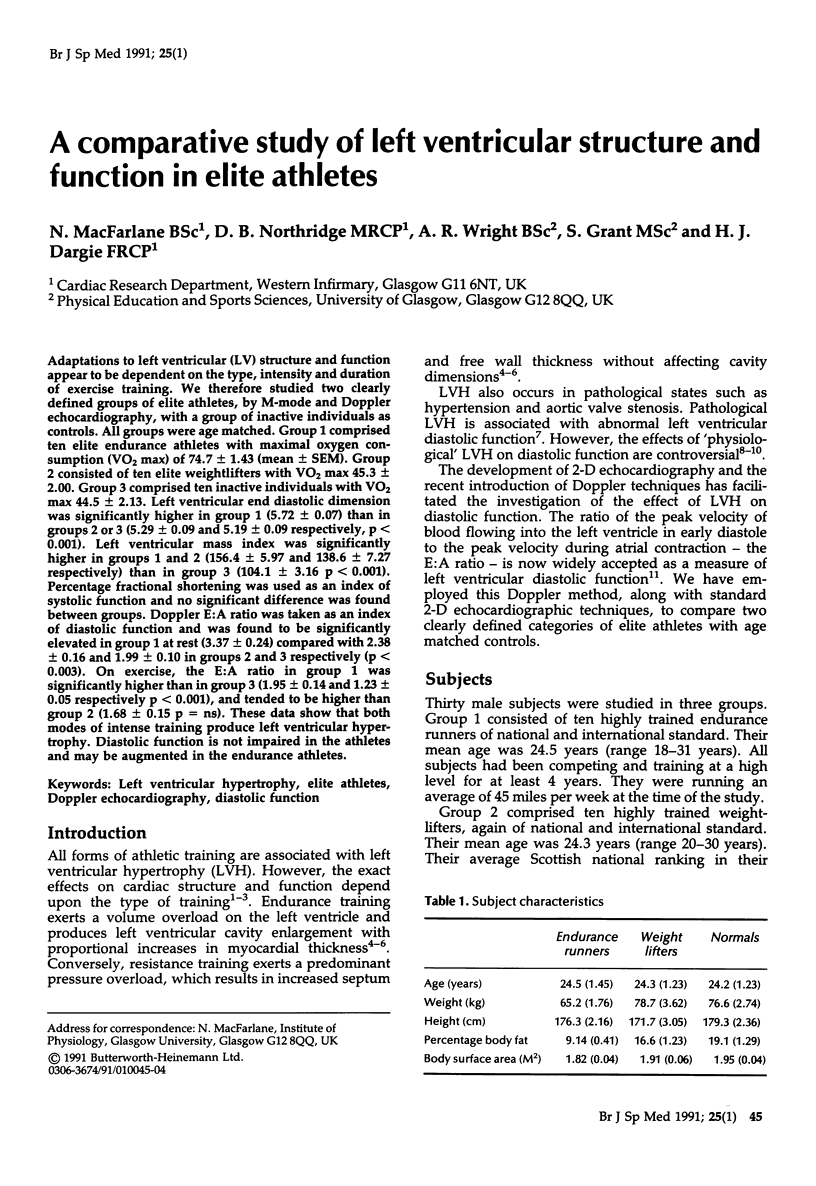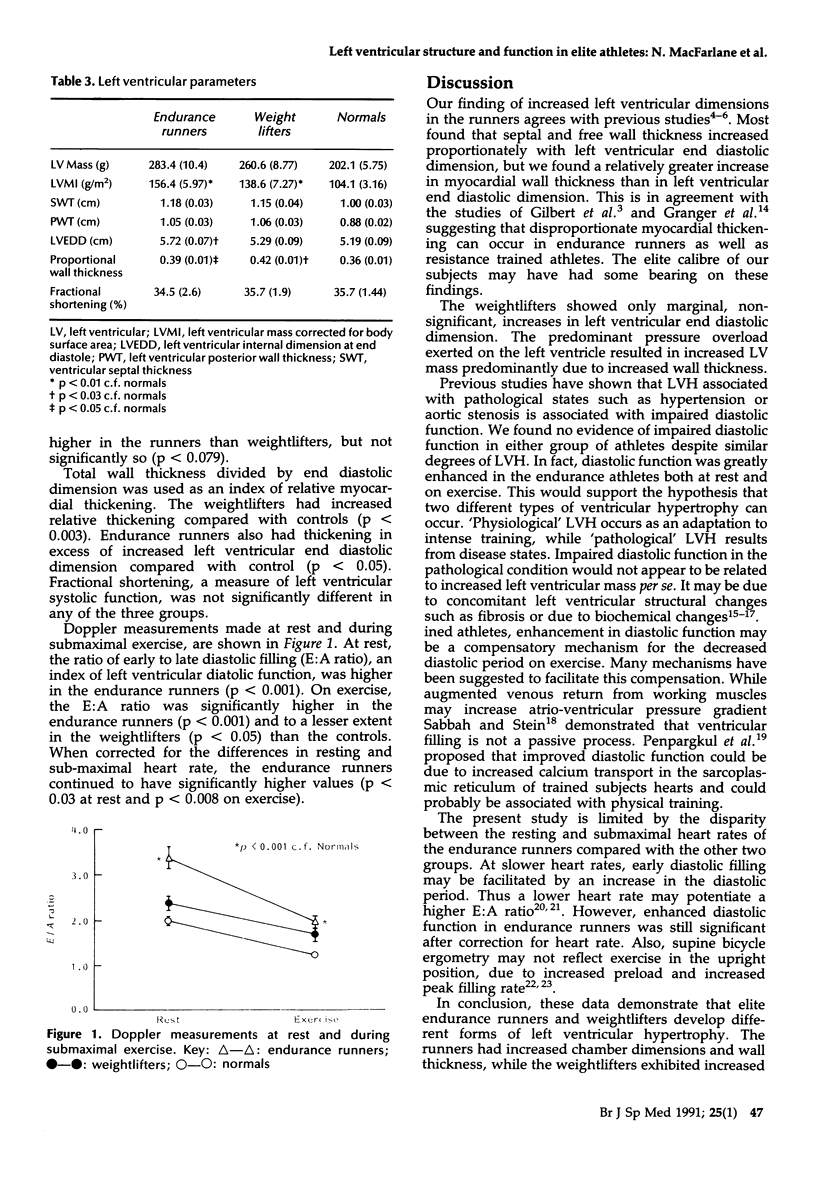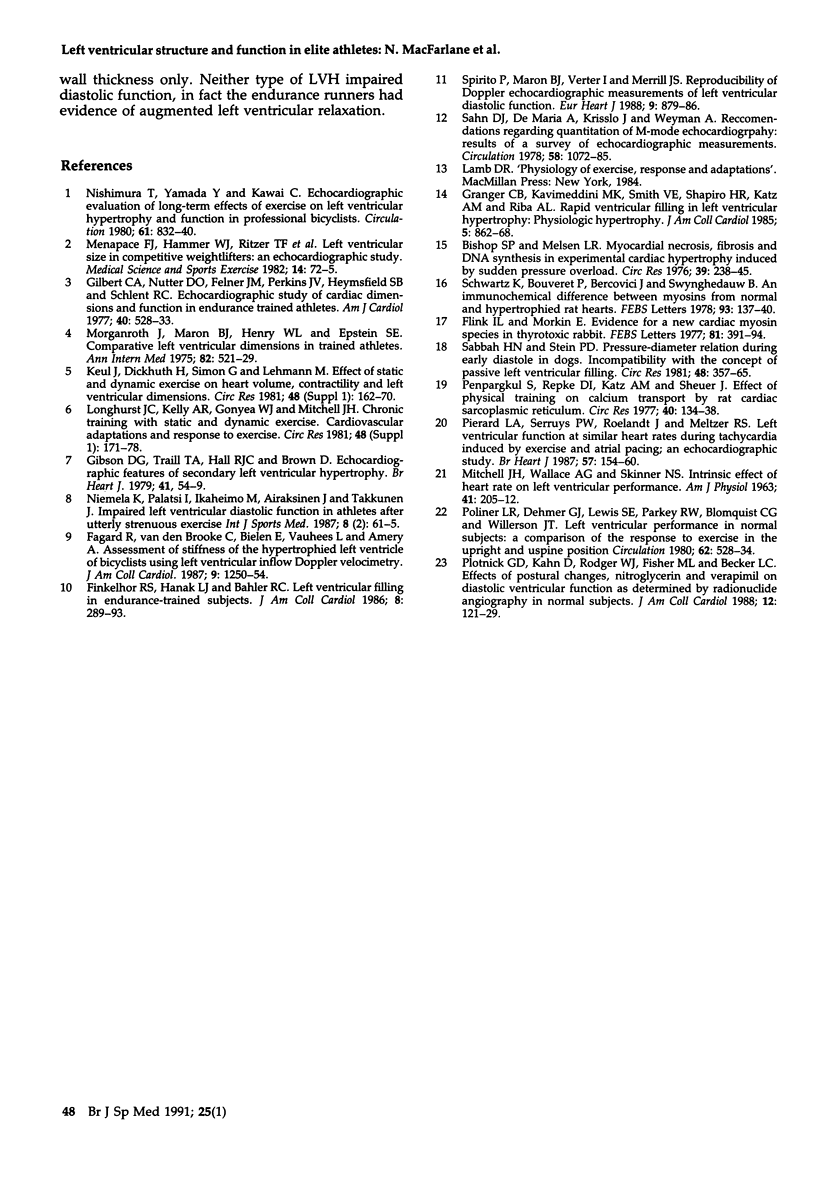Abstract
Adaptations to left ventricular (LV) structure and function appear to be dependent on the type, intensity and duration of exercise training. We therefore studied two clearly defined groups of elite athletes, by M-mode and Doppler echocardiography, with a group of inactive individuals as controls. All groups were age matched. Group 1 comprised ten elite endurance athletes with maximal oxygen consumption (VO2 max) of 74.7 +/- 1.43 (mean +/- SEM). Group 2 consisted of ten elite weightlifters with VO2 max 45.3 +/- 2.00. Group 3 comprised of ten inactive individuals with VO2 max 44.5 +/- 2.13. Left ventricular end diastolic dimension was significantly higher in group 1 (5.72 +/- 0.07) than in groups 2 or 3 (5.29 +/- 0.09 and 5.19 +/- 0.09 respectively, p less than 0.001). Left ventricular mass index was significantly higher in groups 1 and 2 (156.4 +/- 5.97 and 138.6 +/- 7.27 respectively) than in group 3 (104.1 +/- 3.16 p less than 0.001). Percentage fractional shortening was used as an index of systolic function and no significant difference was found between groups. Doppler E:A ratio was taken as an index of diastolic function and was found to be significantly elevated in group 1 at rest (3.37 +/- 0.24) compared with 2.38 +/- 0.16 and 1.99 +/- 0.10 in groups 2 and 3 respectively (p less than 0.003). On exercise, the E:A ratio in group 1 was significantly higher than in group 3 (1.95 +/- 0.14 and 1.23 +/- 0.05 respectively p less than 0.001), and tended to be higher than group 2 (1.68 +/- 0.15 p = ns). These data show that both modes of intense training produce left ventricular hypertrophy. Diastolic function is not impaired in the athletes and may be augmented in the endurance athletes.
Full text
PDF



Selected References
These references are in PubMed. This may not be the complete list of references from this article.
- Bishop S. P., Melsen L. R. Myocardial necrosis, fibrosis, and DNA synthesis in experimental cardiac hypertrophy induced by sudden pressure overload. Circ Res. 1976 Aug;39(2):238–245. doi: 10.1161/01.res.39.2.238. [DOI] [PubMed] [Google Scholar]
- Fagard R., Van den Broeke C., Bielen E., Vanhees L., Amery A. Assessment of stiffness of the hypertrophied left ventricle of bicyclists using left ventricular inflow Doppler velocimetry. J Am Coll Cardiol. 1987 Jun;9(6):1250–1254. doi: 10.1016/s0735-1097(87)80463-1. [DOI] [PubMed] [Google Scholar]
- Finkelhor R. S., Hanak L. J., Bahler R. C. Left ventricular filling in endurance-trained subjects. J Am Coll Cardiol. 1986 Aug;8(2):289–293. doi: 10.1016/s0735-1097(86)80042-0. [DOI] [PubMed] [Google Scholar]
- Flink I. L., Morkin E. Evidence for a new cardiac myosin species in thyrotoxic rabbit. FEBS Lett. 1977 Sep 15;81(2):391–394. doi: 10.1016/0014-5793(77)80561-9. [DOI] [PubMed] [Google Scholar]
- Gilbert C. A., Nutter D. O., Felner J. M., Perkins J. V., Heymsfield S. B., Schlant R. C. Echocardiographic study of cardiac dimensions and function in the endurance-trained athlete. Am J Cardiol. 1977 Oct;40(4):528–533. doi: 10.1016/0002-9149(77)90067-4. [DOI] [PubMed] [Google Scholar]
- Granger C. B., Karimeddini M. K., Smith V. E., Shapiro H. R., Katz A. M., Riba A. L. Rapid ventricular filling in left ventricular hypertrophy: I. Physiologic hypertrophy. J Am Coll Cardiol. 1985 Apr;5(4):862–868. doi: 10.1016/s0735-1097(85)80424-1. [DOI] [PubMed] [Google Scholar]
- Menapace F. J., Hammer W. J., Ritzer T. F., Kessler K. M., Warner H. F., Spann J. F., Bove A. A. Left ventricular size in competitive weight lifters: an echocardiographic study. Med Sci Sports Exerc. 1982;14(1):72–75. doi: 10.1249/00005768-198201000-00014. [DOI] [PubMed] [Google Scholar]
- Morganroth J., Maron B. J., Henry W. L., Epstein S. E. Comparative left ventricular dimensions in trained athletes. Ann Intern Med. 1975 Apr;82(4):521–524. doi: 10.7326/0003-4819-82-4-521. [DOI] [PubMed] [Google Scholar]
- Nishimura T., Yamada Y., Kawai C. Echocardiographic evaluation of long-term effects of exercise on left ventricular hypertrophy and function in professional bicyclists. Circulation. 1980 Apr;61(4):832–840. doi: 10.1161/01.cir.61.4.832. [DOI] [PubMed] [Google Scholar]
- Penpargkul S., Repke D. I., Katz A. M., Scheuer J. Effect of physical training on calcium transport by rat cardiac sarcoplasmic reticulum. Circ Res. 1977 Feb;40(2):134–138. doi: 10.1161/01.res.40.2.134. [DOI] [PubMed] [Google Scholar]
- Piérard L. A., Serruys P. W., Roelandt J., Meltzer R. S. Left ventricular function at similar heart rates during tachycardia induced by exercise and atrial pacing: an echocardiographic study. Br Heart J. 1987 Feb;57(2):154–160. doi: 10.1136/hrt.57.2.154. [DOI] [PMC free article] [PubMed] [Google Scholar]
- Plotnick G. D., Kahn B., Rogers W. J., Fisher M. L., Becker L. C. Effect of postural changes, nitroglycerin and verapamil on diastolic ventricular function as determined by radionuclide angiography in normal subjects. J Am Coll Cardiol. 1988 Jul;12(1):121–129. doi: 10.1016/0735-1097(88)90365-8. [DOI] [PubMed] [Google Scholar]
- Poliner L. R., Dehmer G. J., Lewis S. E., Parkey R. W., Blomqvist C. G., Willerson J. T. Left ventricular performance in normal subjects: a comparison of the responses to exercise in the upright and supine positions. Circulation. 1980 Sep;62(3):528–534. doi: 10.1161/01.cir.62.3.528. [DOI] [PubMed] [Google Scholar]
- Sabbah H. N., Stein P. D. Pressure-diameter relations during early diastole in dogs. Incompatibility with the concept of passive left ventricular filling. Circ Res. 1981 Mar;48(3):357–365. doi: 10.1161/01.res.48.3.357. [DOI] [PubMed] [Google Scholar]
- Sahn D. J., DeMaria A., Kisslo J., Weyman A. Recommendations regarding quantitation in M-mode echocardiography: results of a survey of echocardiographic measurements. Circulation. 1978 Dec;58(6):1072–1083. doi: 10.1161/01.cir.58.6.1072. [DOI] [PubMed] [Google Scholar]
- Schwartz K., Bouveret P., Bercovici J., Swynghedauw B. An immunochemical difference between myosins from normal and hypertrophied rat hearts. FEBS Lett. 1978 Sep 1;93(1):137–140. doi: 10.1016/0014-5793(78)80822-9. [DOI] [PubMed] [Google Scholar]
- Spirito P., Maron B. J., Verter I., Merrill J. S. Reproducibility of Doppler echocardiographic measurements of left ventricular diastolic function. Eur Heart J. 1988 Aug;9(8):879–886. doi: 10.1093/oxfordjournals.eurheartj.a062582. [DOI] [PubMed] [Google Scholar]


